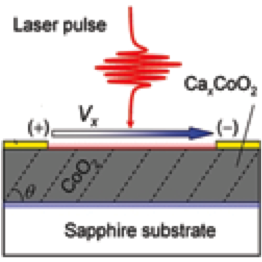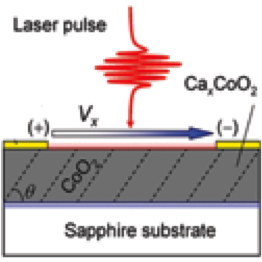It takes two
A significant transverse voltage (more than ) has been observed for several inclined-oriented anisotropic thin films when illuminated by laser light. This effect has been attributed to the off-diagonal thermoelectric effect, in which a temperature gradient orthogonal to the film plane induces a voltage parallel to the plane. However, recent results that deviate from the expected behavior of the thermoelectric effect have caused researchers to propose that the induced voltage may be due to an optical and hence nonthermal effect.
Writing in Physical Review B, Kouhei Takahashi and co-workers at Panasonic Corporation in Kyoto, Japan, present measurements of laser-induced voltages in ( ) thin films at different laser wavelengths. The signals behave as expected for energies lower than the band gap of the film, but for energies above the band gap, the signal is smaller than what would be expected from the off-diagonal thermoelectric effect alone. This deviation is consistent with an interband transition, indicating that a small photovoltaic effect is suppressing the voltage signal. By revealing the nature of the different effects on the signal, this experiment helps resolve the controversy of the responsible effect. The results have bearing on applications such as sensitive thermal sensors and thermoelectric generators. – Brad Rubin





